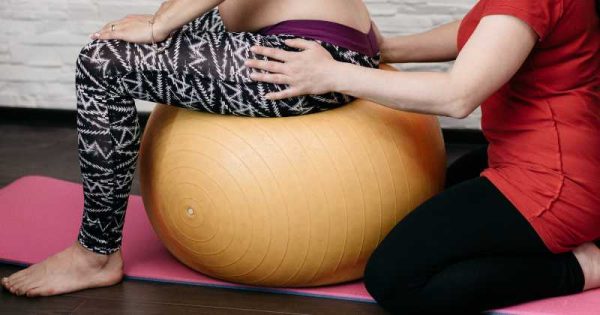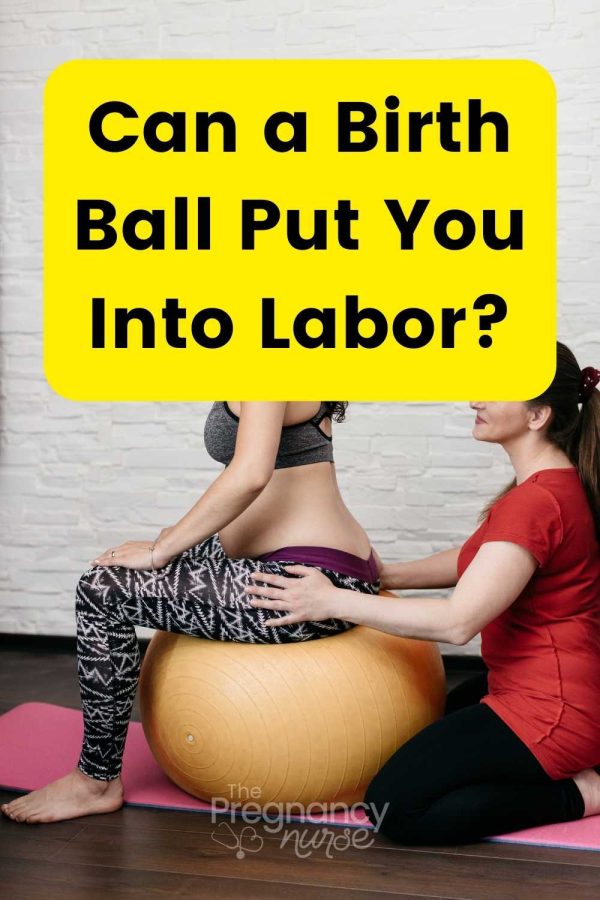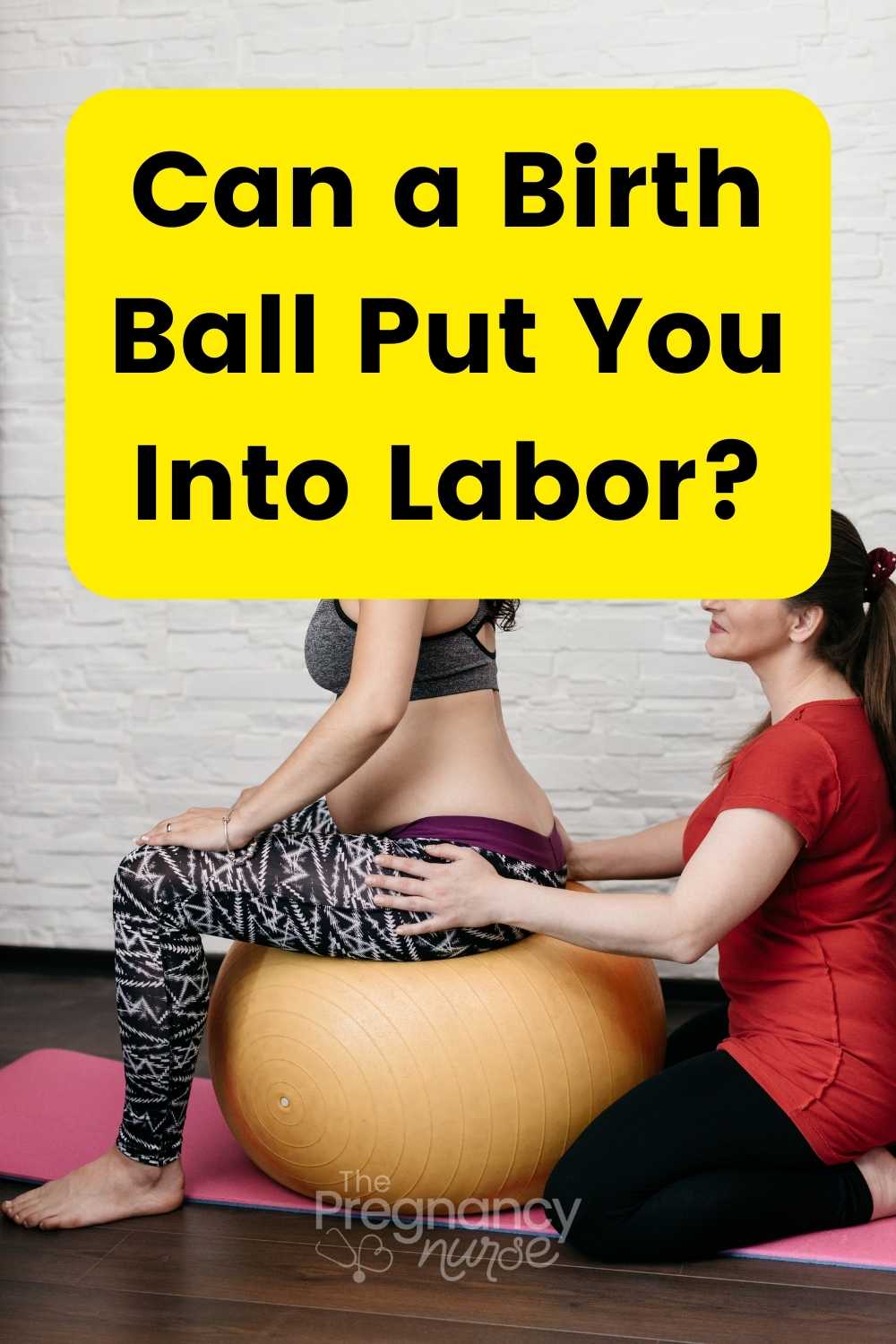Using a birthing ball can have a lot of benefits for your pregnancy. Today I’m going to share when you can start using one, and what purchase it would be for. Don’t fear, if you don’t have a birth ball I’ll give you some great alternatives too!

Before we get going — hello! I’m Hilary, The Pregnancy Nurse®. I’ve been a nurse since 1997 and I have 20 years of labor and delivery experience. I’ve also had my own 3 babies and I have used a yoga ball for both myself and patients, so I know how it can help you too!
And, if you like simple, practical tips for pregnancy and birth be sure to check out this.
Ok, let’s get on with it!
When can you start using a birthing ball?
You can start at any point you think it will be helpful — throughout pregnancy. A birthing ball can be used in many ways to help you through pregnancy and birth including:
- Sit on the ball – it’s a great place that doesn’t put pressure on your tailbone
- Assisting in stretching out lower body muscles and your back
- Moving your pelvis in ways that help both you and baby’s mobility.
As you can tell, most of this could be helpful starting in about the second trimester as your body mechanics change more and your baby belly is poking out more.
But, a lot of people think you bounce on it….
When to start bouncing on birthing ball?
I am going to ruffle some feathers with this one, but I don’t think that bouncing is a good idea at any point in your pregnancy. It may end up being a bit more helpful when baby is born, and they may enjoy some small bouncing movements on the ball to mimic their life in the womb.
Bouncing mostly just angers the ligaments that hold your uterus onto your body — similar to jumping on a trampoline or doing jumping jacks. The labor ball has a LOT of benefits, so let’s talk more about them.
Some light bouncing may feel nice — but I’d stick to horizontal movements, not vertical.
Now, many people (myself included) are a fan of “curb walking” when you’re in labor (or close to it) — I talk about it in this podcast. But the key isn’t the whole “slamming your body down” phenomenon — it’s much more the angle your pelvis is at as you walk (and then turning around so that the other angle is also used), and how different is from your regular walking motion. It just helps baby find their best way out.
And it does it WITHOUT angering your ligaments. Because they’re tired at the end of your pregnancy! BTW if you have tired ligaments I love using a heating pack for them!
What is a birthing ball?
Heads up! 👀 There may be affiliate links in here – I might earn a smidge with your click. No cost to you, just good vibes! Check my boring stuff for deets.
Some of you may be wondering if a yoga ball (also called an exercise ball sometimes) is the same as a birthing ball) — and the answer is yes!
A birthing ball, also known as a birth ball, pregnancy ball, yoga ball, or exercise ball, is a large and inflatable ball that pregnant women can use during pregnancy and labor. The birthing ball is an excellent tool to help women stay comfortable and relaxed during labor. It helps to soothe the joints, reduce stress, and keep the body in a state of balance.

How to Best Use a Birth Ball:
Rotate Your Hips : This is my favorite way to use a birth ball as you get closer to your due date. You’ll just rotate your hips (similar to a hula hoop motion) in a circular or figure eight pattern. It’s just that simple. 🙂 No fancy moves here.
Stretch Assist: Getting into a lunge position to really stretch out your body may be getting harder to do as you get more pregnant. Since the labor ball makes it easy to roll to the side it may help you stretch out tired hip muscles in new ways. It’s not JUST lunging, but I think that makes it easier to picture. I think this video has some good tips on using the birth ball to stretch. There may be some other birthing ball exercises that help you feel good (the ball can also be a fun way to stretch-out your upper body as well).
Kneel Next To It: Often you’ll hear people recommend getting on all fours to help baby get into position, reduce lower back pain and stretch out your hips. However, using your hands can get tiring (and may be extra hard if your forearms or wrists hurt). So, you can just lay over the labor ball. Resting your arms and chest or head on it (great to back this up to something stable like a wall or your couch so the ball doesn’t fly out from under you.
Handy Chair: If your have tailbone pain, the labor ball may be one of your favorite places to sit as it will put less pressure on that area. BTW I have a whole post on some of the best office chairs you can use as well!
Frankly, there’s lots of ways to use it — think about what you’d like to do or what you think would feel good and then see if a yoga ball can help you out!
What Is The Best Birthing Ball?
I recommend a larger one. Probably under 5’8″ I’d recommend a 26 inch ball (65cm), and over that a 30 inch ball (75 cm) — this may vary on if you have a tall torso or legs.
If you’re buying one, be sure to get a color that you think is fun and that you love. It really helps, which seems dumb but it does!
Sometimes I see people trying to use a small birth ball and that can be painful to get on or off of, and may feel very unsteady as you’re on it.
One that’s too large you won’t be able to get the stretching needs that you have.
Alternatives to Birthing Balls
Don’t worry, if you don’t have a birthing ball there are other things you can use.
In fact, in the hospital I have something that I PREFERRED to use over a birthing ball. Mostly because a birthing ball can feel pretty unsteady. When you’re in pain, in a new location and with strangers I wanted people to feel as stable as possible — so I used the doctor’s stool. It helps you shift side to side and stretch out those hip muscles in a similar way. You can use a rolling office chair in a similar way as well.
Just think about leaving your left foot planted, and then you roll to the right and then feel a nice stretch in your inner thigh. Then, switch sides. You can also plant both feel and then shift the chair to the left and right to stretch out those muscles as well.
This is similar to how you might stretch when you’re not pregnant, but you’d likely do that more on the floor — and the floor may feel very far away when you’re pregnant.
Remember if you already have a yoga ball or an exercise ball that you’ve already used doing ball exercises that’s the same thing (as long as it’s big enough) you don’t need to buy a separate birthing ball during pregnancy.
A LOT of people have these types of balls sitting around their house and would be HAPPY to loan them, so maybe ask around before purchasing one if you’re comfortable with that!
Tips For Using a Birthing Ball
When you’re first starting out, I recommend doing it on a carpeted surface instead of a hard surface (like tile or wood). I also recommend doing it next to a person or an object that you can use to steady yourself. For me, this was next to my couch until I got the hang of it.
I still often liked someone to help me get off the ball as it still felt a bit unsteady when I did that.
But, I’d just watch cartoons with my other child rotating my hips on that ball.
Some balls come with a “ring” to slide underneath to keep it from shooting out from under you. I think that’s great if you plan to stay stationary (like using it as an office chair). But, if you want to move and do stretches those rings will prevent you from using it to the full extent.
Bonus: Do some affirmations as you rotate those hips! You’re going to do great!
Using a Birthing Ball to Induce Labor?
As I’ve said before, the birthing ball can help baby find their best spot in your pelvis.
Imagine if you didn’t use your hips much, or only used it one movement (like walking) baby doesn’t get a chance to rotate as much in this scenario. But, rotating those hips, stretching out tired muscles, and getting more relaxed can help baby get into your pelvis.
But it will not induce labor.
Labor requires your baby, your uterus and your brain to all be on the same page to get the party started. Sitting on a birthing ball can help with this:
- Body – It can help you relax as you stretch out muscles
- Baby – It may help baby find their best spot into your pelvis. When baby lowers into your pelvis more it may make you dilate a little (but you need strong contractions to push baby in further)
- Brain – The relaxation helps…
It’s just not enough to push you into labor as far as I can tell. BUT if you’re in early labor I am a huge fan of using the birthing ball during labor to help things progress!
And, if you’re looking at how to go into labor check this out (that also comes in the Bump to Bassinet Bundle with my prenatal class!)
Here are a few favorite questions about inducing labor with a birthing ball:
Birthing ball positions to induce labor:
I would encourage you to stretch and do things that will feel good, but a birthing ball will not induce labor.
Bouncing on ball to induce labor Reviews
0 out of 5 stars here — bouncing on a birth ball could actually stop labor by making all those ligaments ache, and you being miserable. I don’t recommend unless it feels good (sometimes some gentle bounce motions can feel good).
How long to bounce on ball to induce labor?
Stop bouncing on the ball. Rotate those hips. There you go…. 🙂 And just do it as long as it feels good. If you’re not feeling good anymore, stop doing it and get a snack or take a nap. 🙂
What is a peanut birth ball?
Many of you may have heard of a peanut ball. It is not a regular ball-shape, it’s peanut-shaped and can be used to position your hips during labor.
You can do things similar with a birth ball at home (you can do these on the floor, a couch or your bed):
- Laying on your side with one leg up on the ball (and then switch sides)
- Change angles at which your leg is up on the ball to release your pelvis in different ways
In general the peanut ball is smaller and has that nice groove for your leg to fit into. I don’t really recommend people buy a peanut ball to have at home but they are really handy when you’re in labor (especially if you’re planning on getting an epidural).
You could call the hospital you plan to deliver at and see if they have peanut balls you can use when you’re in labor. If not, you can purchase ones on Amazon for not too much.
Should I bring my birth ball to the hospital?
Personally, it’s just one more thing to bring — but if you LOVE being on your labor ball, and it’s your happy place there should not an issue with bringing it. A few thoughts for you:
- You can ask the hospital if they have one you can use when you’re there, and use that instead
- Bring your pump in case it loses air
- Plan to clean it thoroughly afterwards because… hospital floors.
- Use a chux or a towel as you sit on it in case your water breaks (plus, hospital floors)
- Sometimes I have a hard time getting baby on the monitor when patients are on a labor ball. Offer to help the nurse by holding the monitor on if necessary (sometimes they bend out at a weird angle, so just a little gentle pressure can let us keep watching baby).
I do find that as baby gets lower into the pelvis and people feel more birth canal pressure they like the birth ball less (as that’s where it puts more pressure). So, don’t be afraid to STOP using it if it doesn’t feel good anymore (in that case a favorite spot of mine is on the toilet or a commode chair as that leaves that area open.
You can also use a birth ball to help you get into an “all fours” position with the ball up on the bed and you resting on it. This position can sometimes help a baby to turn into a more suitable position.
So, that’s all my thoughts on birth balls. I’m actually a HUGE fan of them when used correctly. I really think that pelvic circles got me from 2 cm to 4 cm with my second baby. Mostly because it helped him find his best way down. It didn’t put me into labor, but it gave him a good shot to get into my pelvis so, when labor started we were already in the right place.
I hope I de-mystified a lot of birth balls for you in this post. If you like simple ideas to make pregnancy easier come join me in The Online Prenatal Class for Couples — the simple way to get prepared for your birth! In just a few hours you can feel confident and prepared for your hospital birth!
Looking to get prepare for your birth? I have some easy options for you!
~~~~~~~~
– Worried you’re missing something? Grab my pregnancy planner so you don’t miss a thing!
– Thinking about an induction? Grab Inductions Made Easy to feel prepared in just 20 minutes!
– Wondering how to get that baby OUT? Grab Going Into Labor Made Easy so you know how to (and not to) do it!
– Postpartum got you anxious? Check out Postpartum Care Made Easy so you can stay SAFE even when all your attention is on that little on.
🚨 AND if ALL OF IT has got you on edge The Online Prenatal Class for Couples is perfect for you — You’ll feel so ready before you even know it!
~~~~~~~~
No matter WHERE you are at in your pregnancy journey, we have resources that can help!
And, if you’re not quite sure you’re ready for that whole thing, check out my free prenatal class. It’s your first step toward getting in the driver’s seat of your birth.







 Avoid Failing the Glucose Test During Pregnancy
Avoid Failing the Glucose Test During Pregnancy
